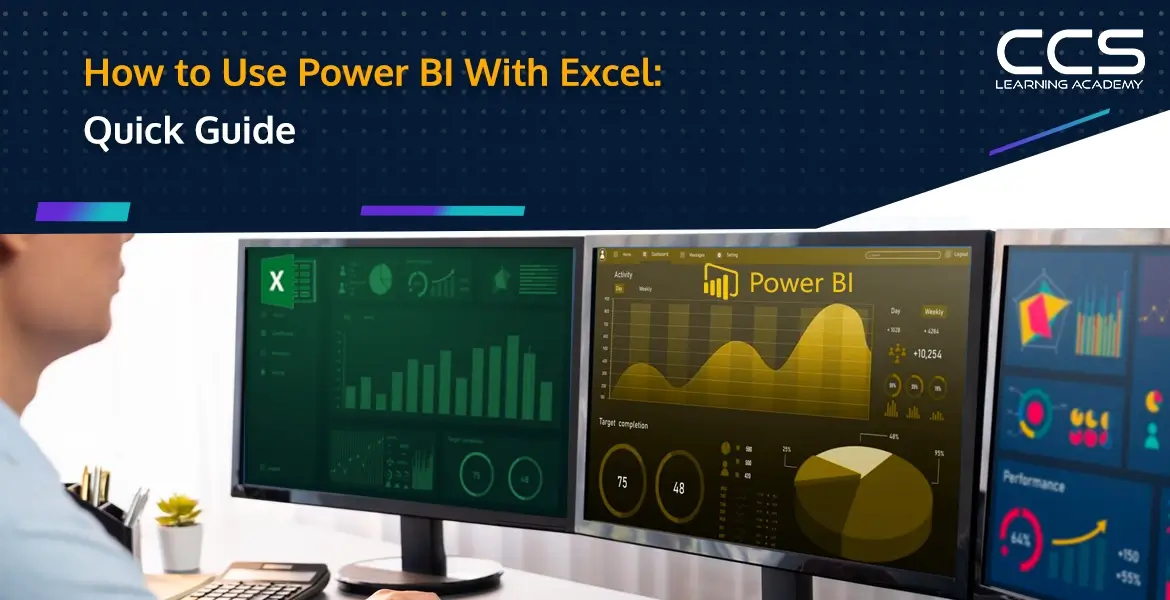How to Use Power BI with Excel: Quick Guide [2024]
- -
- Time -

Do you want to analyze big data and import them to Excel manually? Do yourself a favor and start using tools for analysis. Some of the best tools for studying are Power BI and Excel. Both these tools allow you to create reports and dashboards that help you visualize data and derive meaningful insights from it. Have you ever considered what it will be like if Power BI and Excel are integrated?
The most potent combination will help you obtain valuable insights quickly and will allow you to make data-driven decisions. So, what are you waiting for? Discover the powerful integration of both tools by knowing how to use Power BI with Excel. In this guide, we will help you learn how to do it. With this, you can maximize your data analysis and data visualization process.
Understanding Power BI
Power BI is a very advanced business intelligence tool that Microsoft has developed. It allows users to connect, visualize, and transform data from multiple sources. The interactive dashboards and reports help users manage and arrange their data in a more presentable format. The Power BI tool lets businesses quickly analyze data and gain valuable insights to make informed decisions.
The user-friendly interface of this tool offers features such as data sharing, data visualization, and data modeling. This tool is used by almost every business across the industry for data analysis. Reporting and collaboration also become easy with this tool.
It is a versatile and flexible tool that gives practical solutions to businesses. These solutions are further implemented in the industry to maximize the potential of data. You can learn Power BI fundamentals by taking the CCSLA course PL-300: Microsoft Power BI Data Analyst.
Understanding the Basics of Excel
Before you know how to use Power BI with Excel, you should be aware of both tools briefly. Excel is a top-rated spreadsheet program that has also been created by Microsoft. It enables users to store and manipulate data by analyzing it. Various formulas, functions, and charts are supported in Excel, which makes it best to analyze and manipulate data.
This versatile program has multiple unique features, including the ability to sort and filter data. Learn fundamentals to advanced concepts from Microsoft Office Excel (2019-2016-2013): Advanced on CCSLA to get a clear understanding of Excel.
Creating pivot tables, generation of visualization, and other factors help users gain valuable insight from data. The application is frequently used for financial modeling, analysis, project management, budgeting, and data tracking. It comes with more customizable options, which allow professionals to work according to their preferences.
Any integration in Excel is done through Excel Plugin features, which come in-built. Extending its reach of documents and keeping track of every operation is a good way for a business.
How to Use Power BI with Excel?
Power BI and Excel both increase the performance and visualization capabilities of the business. Their integration will enhance the overall operational capability and will improve the decision-making process.
So, let’s see how to use Power BI with Excel in this step-by-step guide:
Step 1: Download and Install Power BI Desktop
To get Power BI on your desktop, download its application by following the given steps:
- Visit the official website of Microsoft Power BI.
- Click on the Downloads tab.
- Scroll down to see the Power BI desktop section.
- Click on the Download button there.
- Once the application is downloaded, find the file and initiate the installation process.
- Follow the on-screen prompts to finish the installation.
- After installation is complete, you can launch the Power BI desktop and start using it.
Step 2: Connect Power BI to Excel
Once the Power BI tool is downloaded and installed on the desktop, connect it to Excel. To do so, follow these steps:
- Open the Power BI desktop.
- Now, find the Get Data option and click on it.
- Select Excel from the drop-down list of data sources.
- Choose the Excel file that you want to connect with.
- Select the specific table or data range that you may wish to import later.
- Click on Load to import the data directly into Power BI.
- Once done, you can start creating data visualization and reports for your business.
Step 3: Import Data from Excel to Power BI
To import data from Excel to Power BI, you can follow the below-given steps:
- Open the Power BI desktop tool and click on ‘Get Data’ from the Home tab.
- Now, select Excel from the drop-down list of data sources.
- Navigate to the location of the file of Excel you choose to import from a specific worksheet or table.
- Click ‘Load’ to import the data from Excel into Power BI.
By using these steps, you can easily integrate your Power BI tool with Excel and start creating your data visualization and reports for your business. You can take total advantage of both these integrations with advanced analytics and capabilities for insightful data analysis.
Significant Differences Between Power BI and Excel
Once you know how to use Power BI with Excel, you should also understand their specific differences. Power BI and Excel are both data analysis tools that have distinct differences, some of them are as follows:
- Functionality: Excel is a spreadsheet program, and you may need help to handle large amounts of data. Power BI is a business intelligence tool designed to visualize data and perform interactive operations like preparing reports.
- Data Sources: Excel can handle smaller datasets compared to Power BI. Power BI can handle large and complex sets from multiple sources, including cloud services and databases.
- Collaboration: Power BI allows users to share files and collaborate on reports and dashboards. On the other hand, Excel requires manual sharing of files.
What are the Benefits of Using Power BI and Excel Together?
When it comes to data analysis, the combination of Power BI and Excel offers efficient solutions to businesses. There are many more benefits of using this integration of Power BI and Excel. From real-time analysis to interactive visualization, the integration offers extensive benefits.
Let’s explore how the integration allows for easy sharing and collaboration and streamlined data sharing with teams.
Real-time Data Analysis
Real-time data analysis is an essential feature of PowerBI and Excel integration. Following are some steps by which both these tools perform real-time data analysis:
- Connect to the live data source, such as a live streaming service or database, to access the real-time data.
- Set up automatic data refresh intervals to ensure the analysis is always up to date.
- Create real-time visualization like live charts or dashboards.
- Use Power BI in real time to stream capabilities of receiving constant updates and analyzing data.
- By tracking sales using integration, you can identify sales trends, shift any product demand, and optimize inventory management. Data-driven pricing decisions result in increased profitability and sales.
Interactive Visualizations
Power BI and Excel offer dynamic and engaging ways to explore and analyze data. To create one and to see what benefits it provides to businesses, check the following points:
- Import data: Connect Power BI to your data source, like Excel, and import the relevant data.
- Create visualization: Use the Power BI interface to select various visualization options like charts, graphs, and maps.
- Add interactivity to it: You can personalize your visualization by integrating two. You can incorporate interactive elements kike slicers, drill-through, and filters.
- Design dashboard: Arrange your visualizations on a dashboard to create a checklist and interactive reporting experience.
- Improve your interaction: With dashboard facilities, you can easily use your interactive features like cross-highlighting and cross-filtering.
Easy Collaboration
Collaboration is easy with Power BI and Excel. You can get various advantages from the easy collaboration feature of this integration.
- Share dashboard and reports: Power BI and Excel allow you to share reports and dashboards with colleagues, which in turn promotes real-time collaboration.
- Create groups: Users can create several groups to collaborate with specific teams or departments, ensuring seamless sharing and collaboration.
- Use comments and annotations: Power BI allows users to comment and conveniently prepare reports and dashboards. This provides communication and feedback.
- Improves data refresh: Collaborators often schedule automatic data refreshes in Power BI, which ensures that people have access to the most updated information.
Tips for using Power BI and Excel Together
When you learn how to use Power BI with Excel, you should understand some of its factors before implementing the steps. Though both these tools work together to create informative and dynamic reports, they require some foundational steps to carry out and be taken care of.
Here are some tips that you should follow to make the most of your data and create visually appealing and interactive reports:
Keep Your Data Organized
Maintaining organized data is essential for using Power BI with Excel. To ensure that data is well-organized, follow the given steps:
- Establish consistency in the data.
- Use separate sheets and tables for different categories of data.
- Format your data using the same data types, and when conditional formatting is needed, use that.
- Ensure that your data does not contain any errors or duplications.
- Use descriptive headers and labels for columns to understand the data correctly.
Use Filters and Slicers for Interactive Visuals
Using filters and slicers in Power BI can improve the interactivity and usability of your reports. Here are some tips that you should follow to use filters and slicers effectively:
- Drag and drop the desired field into the ‘Filters’ pane.
- Select the appropriate filter type from the drop-down list.
- Apply the filter or slicer to the desired visualization.
- For better filtering options, use slicers. Add the slicer visuals to your reports and choose the field that you want to slice.
- Customize the slicer settings using orientation, number of items shown, and alignment.
- Interact with slicers to filter the data in real time and observe the impact of better visualization on your report.
Use Custom Visuals and Third-Party Add-Ons
To customize visuals and create the best report and dashboard, follow the below-given steps:
- Install the Power BI desktop tool and open it.
- Now, connect it with Excel by selecting the ‘Get Data’ option.
- Choose the Excel file that you want to import.
- Importing data from Excel to Power BI requires the selection of sheets and tables.
Furthermore, you can use third-party add-ons to create engaging and attractive visuals and to improve the analysis process for business.
Conclusion
Integrating Power BI with Excel can be very useful for businesses, especially for data analysts, as it allows them to function quickly and effectively. Creating potential and efficient data increases analytical abilities and unlocks the insights for executives to make impactful decisions.
By understanding how to use Power BI with Excel, businesses get the ability to analyze big data and derive solutions from them quickly. With the right strategies and techniques, the Power BI dashboard with Excel can be used to create pivot charts, engaging reports, and many more to help organizations make more informed decisions based on data-driven insights.
If you are looking for an opportunity to learn how to use Power BI and Excel for data analysis, you can choose the most suitable course for yourself. Data analytic demand is increasing, and you need to opt for the best. The CCSLA bootcamp training Data Analytics & Engineering Bootcamp offers you the fundamental knowledge and highly focuses on giving practical experience with several live projects with flexible schedules. You will get job placement assistance and one-to-one mentorship for your internship guidance as a certified trainer.
FAQs
Power BI is a business analytics service by Microsoft that provides tools for aggregating, analyzing, visualizing, and sharing data. Power BI’s relationship with Excel is complementary; users can import Excel datasets into Power BI for advanced analytics and visualization, or use Excel to view and manipulate data models created in Power BI.
Using Power BI with Excel allows you to leverage the advanced visualization and analytics capabilities of Power BI along with the familiar spreadsheet management functions of Excel. This integration is especially useful for users looking to enhance their Excel data with interactive reports or need more robust data modeling capabilities.
To import Excel data into Power BI, start Power BI Desktop, go to the ‘Home’ tab, and click on ‘Get Data’. Select ‘Excel’ from the options, then browse to find your Excel file. After selecting the file, Power BI will let you choose the specific sheets or tables you want to import.
Yes, you can export data from Power BI reports into Excel. In Power BI service, you can export the data of a visualization by clicking on the ellipsis in the upper right corner of the visualization and selecting ‘Export data’. This allows you to download the data as an Excel file (.xlsx).
Best practices for using Power BI with Excel include ensuring data quality and structure in Excel before import, using Power Query in Excel to clean data, and maintaining consistent data updates between Excel and Power BI. Also, consider using Excel as a detailed, data-rich supplement to Power BI’s visual storytelling.
One limitation when using Power BI with Excel is that not all Excel functionalities and formats are supported in Power BI, such as cell formulas and some advanced chart types. Additionally, while you can import data from Excel into Power BI, maintaining a live, two-way sync between these platforms is not possible.
To refresh Excel data in Power BI after making updates to your Excel file, you need to refresh the dataset in Power BI Desktop or Power BI service. If your Excel file is stored on OneDrive or SharePoint, Power BI can automatically refresh the data as changes are made in Excel.
Yes, you can use Excel to perform calculations and then import this data into Power BI. However, for complex data models, it’s often better to use Power BI’s DAX (Data Analysis Expressions) language, which can handle dynamic calculations across data models more efficiently.
Combining Power BI and Excel enhances your ability to analyze and report on data. Power BI provides advanced data visualization and dashboard capabilities, while Excel offers robust spreadsheet functions, detailed formatting, and additional computational tools. Together, they provide a comprehensive data analysis and reporting solution.
Yes, Power BI visuals can be embedded in Excel. Using Power BI and Excel for Office 365, you can insert live Power BI visualizations into Excel spreadsheets, which can be interacted with directly within Excel.






